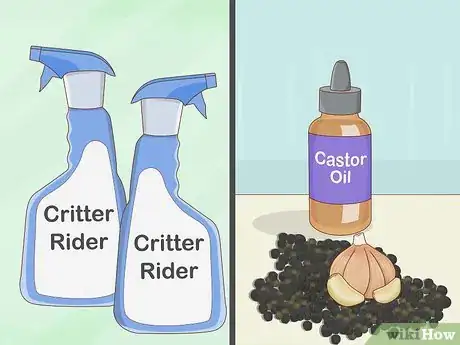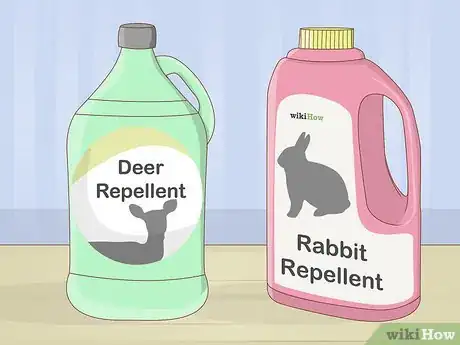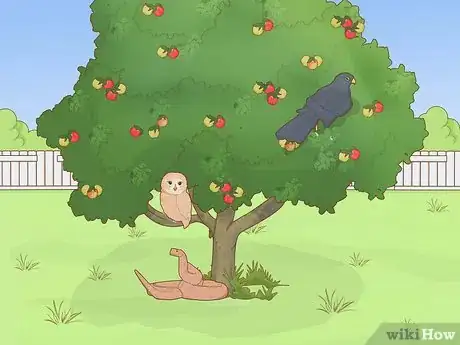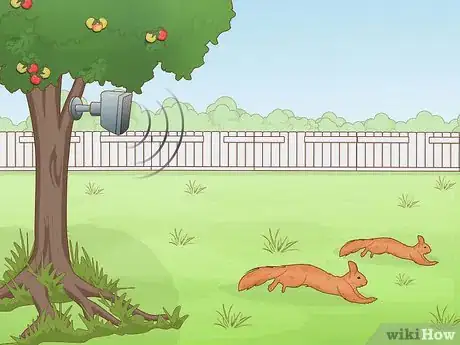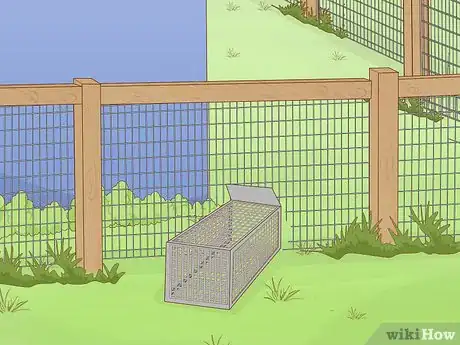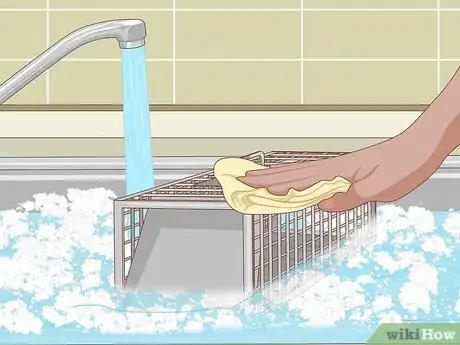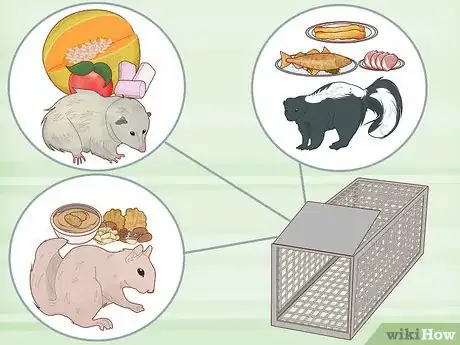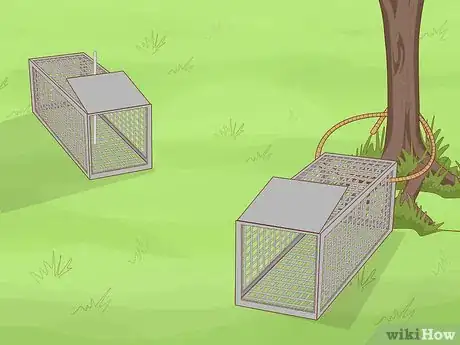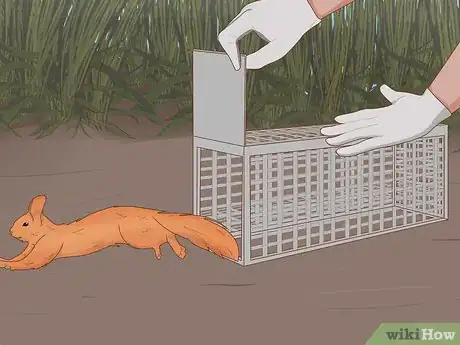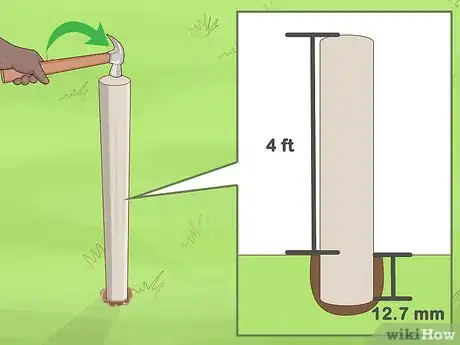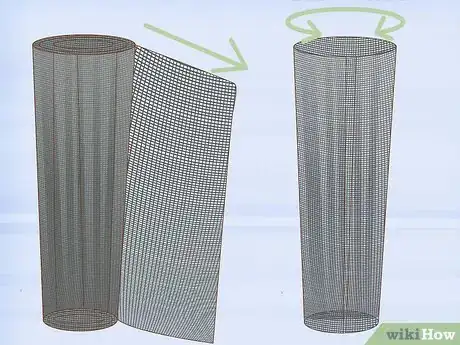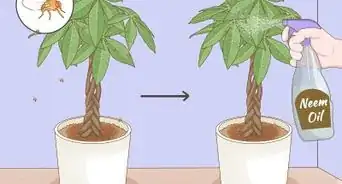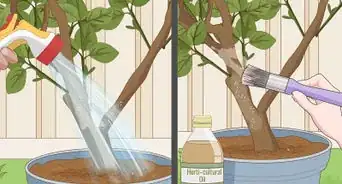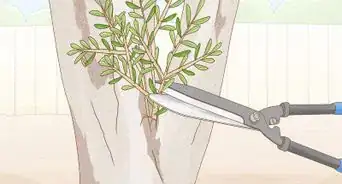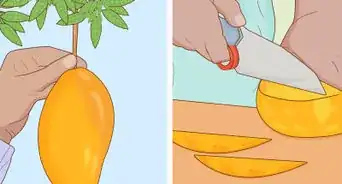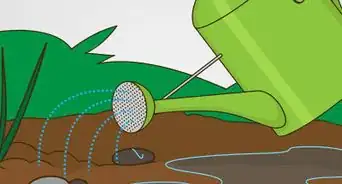This article was co-authored by Lauren Kurtz. Lauren Kurtz is a Naturalist and Horticultural Specialist. Lauren has worked for Aurora, Colorado managing the Water-Wise Garden at Aurora Municipal Center for the Water Conservation Department. She earned a BA in Environmental and Sustainability Studies from Western Michigan University in 2014.
There are 10 references cited in this article, which can be found at the bottom of the page.
This article has been viewed 32,923 times.
Caring for fruit trees can be a fun and relaxing activity that reduces your stress and gives you access to fresh fruit. However, fruit trees can sometimes be destroyed by foraging animals like squirrels, rabbits, and raccoons. Because it usually takes a lot of time for trees to bear fruit, this can be incredibly frustrating. Luckily, there are various methods of protecting your trees from animals. You can either trap the animals, use repellents and other methods to scare them, or install tree guards to protect them from damage.
Steps
Warding off Animals
-
1Use a kaolin clay-based repellent. A kaolin clay-based repellent is made of naturally occurring ingredients and can help repel animals and insects from eating the fruit off your tree. You can purchase the repellent at some nurseries or find it online. This repellent will leave a white film on your fruit and tastes bad to most animals and insects. Kaolin clay repellents are not useful for fuzzy fruits like peaches or apricots or smaller fruits like cherries or plums.[1]
- Kaolin clay repellents are hard to get off, so make sure that you wash your fruit thoroughly before consuming it.
-
2Use a chemical or organic repellent. Some chemical repellents are not healthy for human consumption. Make sure to find a chemical based critter repellent that is safe for your fruits. Before spraying the area with the solution, make sure to read the label for any special details or instructions that you should know.[2] Some fruit-friendly natural repellents will include ingredients like pepper, peppermint, tarragon, garlic, castor oil, and putrescent egg solids.Advertisement
-
3Purchase an animal-based repellent. Animal repellents like predator urine or musk may ward animals off of your fruit trees. Read the instructions on the bottle of the repellent before using it. In general, you can usually spray these repellents two feet away from the trunk of your trees to discourage animals from eating your fruit.
-
4Get fake animals to scare away real ones. Fake animals like hawks, owls, and snakes can act as scarecrows to the critters infesting your fruit garden. Place these props around your garden to ward off animals.
- You can also attract real predators by making roosting spots for real hawks and owls by placing crossbeams six to eight feet off the ground.[3]
-
5Play sounds or noise to ward off animals. Playing a radio is a great way to scare away potential predators from your garden. You can also opt to buy a more specialized ultrasonic repellent that sends ultrasonic sound waves to ward off rodents and other garden critters.[4]
- It's important to note that eventually the animals may become accustomed to the noise, and ignore the source of the sound.[5]
- If your radio has an alarm or timer, playing the noise intermittently may work better to ward off critters.
Trapping Live Animals
-
1Set the trap in a known animal route. If your fruit trees have been disturbed by an animal in the past, there is likely a route that the animal habitually takes to gorge on your plants. Places like a hole in your fence, a well-worn path leading from the garden, or entrances leading to a burrow are obvious signs of a known route. Set your trap up on these routes to maximize the chance that you'll catch it.[6]
- You can maximize your chances of catching a burrowing animal by setting the trap up directly at the entrance of the hole.
- If you can't find an obvious path the animal takes, scope out the tree from afar with binoculars and try to catch the animal in action.
-
2Mask your scent on the trap. A human scent on a trap can act as a deterrent for most animals and can prevent you from successfully trapping your animal. There are two main ways that you can mask your scent on the trap that you plan on using. One way is to wash the trap with a mild soap, then immerse it in boiling water to remove your scent. Another way to mask your scent is by leaving the trap outdoors in the sunshine for several days. Moving your trap outdoors will make the trap smell like the surrounding environment.[7]
-
3Determine what animal is eating your fruit. Animals like chipmunks, squirrels, and rabbits will usually exhibit signs such as biting off large parts of the plant, eating an entire plant to the ground, or removing and damaging individual fruit. Look for these signs to verify that your plants are being eaten by a mammal and not insects. Knowing which animal is eating your plant will help you get the right bait and appropriately sized trap. Monitor your plants and see which animals are pestering them.[8]
- If you can't determine what animal is eating your fruit plants, you can set up hidden cameras to catch the animals in the act.
- If your plants are slowly being eaten away and there are small holes all over your fruit, chances are that insects have been eating it.
-
4Lay the appropriate bait in your trap. Different animals prefer different foods and will be attracted to different baits. For example, rabbits prefer foods like apples, carrots, pea pods, peppermint, or cider sprayed over the trap while raccoons enjoy sugar filled foods like marshmallows as well as different kinds of fish. Use the right bait for the animal that is eating your fruit plants. [9]
- Opossums eat marshmallows, apples, melons, other fruit.
- Skunks prefer chicken, fish, and bacon.
- Squirrels enjoy nuts, seeds, and peanut butter.
-
5Set the trap up so it stands upright. A loose cage on the ground can be tipped over or manipulated by the animal in your yard. The doors on most live traps will only stay closed when the trap is sitting upright. To keep your trap standing upright, shove a metal rod through the trap into the ground to hold it in place. Alternatively, you could strap the trap to a tree or pile of rocks to secure it. Make sure that the trap is secure and won't fall over if an animal gets caught in it.[10]
-
6Release the animal in a forest or park. Since all of these methods use no-kill traps, the final step in your animal trapping journey is to release them into the wild. Take the animal to a park or forest and carefully tip the trap to release it. Wild animals, even smaller mammals can be dangerous or carry disease, so be incredibly careful when releasing the critter. Confirm with your local park department if it's okay to release the animal you've trapped before you release it. If it's not authorized, then call animal control to come to your house to remove the animal.[11]
- Wear thick construction gloves, a long-sleeve shirt, pants, and boots to protect yourself from animal bites when handling the trap.
- Have someone go with you in case you need help.
Installing Tree Guards
-
1Drive a 4-foot (1.2 meters) wooden stake into the ground. Use a hammer to tap the top of the stake into the ground a half inch (12.7 mm) into the ground. The post should be one or two inches away from the tree or plant that you want to protect.
- If you are trying to protect a larger fruit tree, make sure that you get a long enough post so that animals won't be able to reach your fruit.
- If you're working with a larger tree, you may need to use more than one stake.
-
2Roll your mesh sleeve up. Press down on the edges of the sleeve and roll the sleeve lengthwise. This will help open up the wire mesh so that you can slide it over your fruit tree. Once it's rolled, unroll it and open up the mesh so it looks like a tube.
-
3Slide the mesh sleeve around the post. The wire mesh sleeve should fit over the stake that you put into the ground as well as your fruit tree. If the trunk of your fruit tree is larger, you may have to wrap the wire mesh around the tree.
-
4Staple the mesh around the post. Overlap the wire mesh on top of the post in the ground and carefully staple it one inch from the top and bottom of the post. Continue to add staples with a staple gun every inch apart until the mesh sleeve is securely fastened to the post in the ground.
-
5Cut off any remaining mesh on the top of your post. If there is leftover mesh on the top of your tree guard, it could prevent the tree from growing. Use wire cutters to cut off any remaining mesh at the top and allow there to be a hole so that your tree can continue growing.
Expert Q&A
-
QuestionHow can I protect my tree from donkeys and goats?
 Lauren KurtzLauren Kurtz is a Naturalist and Horticultural Specialist. Lauren has worked for Aurora, Colorado managing the Water-Wise Garden at Aurora Municipal Center for the Water Conservation Department. She earned a BA in Environmental and Sustainability Studies from Western Michigan University in 2014.
Lauren KurtzLauren Kurtz is a Naturalist and Horticultural Specialist. Lauren has worked for Aurora, Colorado managing the Water-Wise Garden at Aurora Municipal Center for the Water Conservation Department. She earned a BA in Environmental and Sustainability Studies from Western Michigan University in 2014.
Professional Gardener Trees are best protected from donkeys and goats by building a strong fence around them. Goats can climb and jump and donkeys are large, strong, and capable of knocking down weak fences. Use concrete to set the wooden posts into the ground at least 1.5 feet deep. Use livestock wire, barbed wire, or wood to build the rest of your fence. Make sure the fence is large enough so donkeys can’t reach the fruit from outside the fence. Be cautious of large tree roots when digging post holes.
Trees are best protected from donkeys and goats by building a strong fence around them. Goats can climb and jump and donkeys are large, strong, and capable of knocking down weak fences. Use concrete to set the wooden posts into the ground at least 1.5 feet deep. Use livestock wire, barbed wire, or wood to build the rest of your fence. Make sure the fence is large enough so donkeys can’t reach the fruit from outside the fence. Be cautious of large tree roots when digging post holes.
Things You'll Need
Trapping Live Animals
- Animal trap
- Animal bait
Installing Tree Guards
- 4-foot wooden stake
- Hammer
- 6 to 10 mm staples
- Staple gun
- 3-foot mesh sleeve
References
- ↑ http://www.rodalesorganiclife.com/garden/defend-your-fruit-trees-squirrels
- ↑ http://www.plantskydd.com/repellent.html
- ↑ http://www.gardensalive.com/product/the-ultimate-squirrel-solution/you_bet_your_garden
- ↑ https://www.todayshomeowner.com/do-ultrasonic-electronic-pest-repellents-work/
- ↑ http://www.hobbyfarms.com/protect-your-livestock-from-predators-2/
- ↑ http://www.motherearthnews.com/homesteading-and-livestock/traps-for-garden-pests-zbcz1608
- ↑ http://www.pestproducts.com/animaltrapping.htm
- ↑ https://ag.umass.edu/sites/ag.umass.edu/files/fact-sheets/pdf/whats_eating_my_vegetables.pdf
- ↑ http://www.hsi.org/assets/pdfs/eng_ht_set_live_trap.pdf

